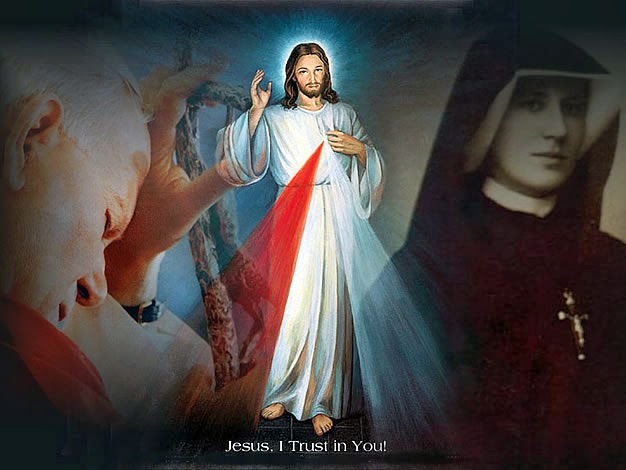
The Image of The Divine Mercy originated from a vision St. Faustina had on Feb. 22, 1931. She recorded the event in her Diary, which she kept at the Lord’s request.
She wrote:
In the evening, when I was in my cell, I saw the Lord Jesus clothed in a white garment. One hand [was] raised in the gesture of blessing; the other was touching the garment at the breast. From beneath the garment, slightly drawn aside at the breast, there were emanating two large rays, one red, the other pale. In silence I kept my gaze fixed on the Lord; my soul was struck with awe, but also with great joy. After a while, Jesus said to me, “Paint an image according to the pattern you see, with the signature: Jesus, I trust in You. I desire that this image be venerated, first in your chapel, and [then] throughout the world” (Diary, 47).
Under the direction of St. Faustina and her confessor, Blessed Michael, Sopocko, the artist Eugene Kazimirowski, of Vilnius, painted the image in 1934-35. Saint Faustina was not impressed, to say the least. She felt that the painted image was not even close in magnificence to the vision she had of our Lord. She wrote:
I felt very sad about it, but hid this deep in my heart. When we had left the artist’s house, Mother Superior [Irene] stayed in town to attend to some matters while I returned home alone. I went immediately to the chapel and wept a good deal. I said to the Lord, “Who will paint you as beautiful as You are?” Then I heard these words: “Not in the beauty of the color, nor of the brush lies the greatness of this image, but in My grace” (Diary, 313).
Incidentally, other artists have since painted their own versions of the Image of The Divine Mercy. Kazimirowski’s version (now known as the Vilnius image) is one of three versions of the Image of The Divine Mercy that have ecclesiastical approval for display in churches and for dissemination to the faithful.
So what does the image mean? The Image of The Divine Mercy represents the risen Christ whose hands and feet bear the marks of the Crucifixion. When asked about the meaning of the rays from His pierced Heart, Jesus explained, “The pale ray stands for the Water which makes souls righteous. The red ray stands for the Blood which is the life of souls. … These two rays issued forth from the very depths of My tender mercy when My agonized Heart was opened by a lance on the Cross” (Diary, 299).
In other words, these two rays signify the sacraments of mercy (Baptism and Penance), and the Eucharist. The Eucharist is the blood of souls, carrying life-sustaining food for our spiritual journey. The water is analogous to the sacraments of Baptism and Penance, in that through these sacraments our souls are washed clean. “But you were washed, you were sanctified, you were justified in the name of the Lord Jesus Christ and in the Spirit of our God (1 Cor 6:11). “Happy is the one who will dwell in their shelter,” said Jesus, “for the just hand of God shall not lay hold of him” (Diary, 299).
Jesus attached many promises to those who venerate the image. What does it mean to venerate an image? It simply means we regard with great respect and reverence the person portrayed in the image, an action which is not contrary to the First Commandment. People carry pictures of their loved ones in their wallets; this does not mean they love the picture, per se. Rather, it reminds them of someone they truly love.
Saint Thomas Aquinas, in his Summa Theologiae, said the following: “Religious worship is not directed to images in themselves, considered as mere things, but under their distinctive aspect as images leading us on to God incarnate. The movement toward the image does not terminate in it as image, but tends toward that whose image it is” (Catechism of the Catholic Church, #2132).
And certainly the image of the Resurrected Jesus, with His pierced hands and feet, reminds us of the love God has for us. Jesus loves us so much that He died for each one of us! Jesus said, “I am offering people a vessel with which they are to keep coming for graces to the fountain of mercy. That vessel is this image with the signature: ‘Jesus, I trust in you'” (Diary, 327).
He said, “By means of this image I shall be granting many graces to souls; so let every soul have access to it” (Diary, 570).
Jesus also said: “I promise that the soul that will venerate this image will not perish. I also promise victory over [its] enemies already here on earth, especially at the hour of death. I Myself will defend it as My own glory” (Diary, 48).
Our Lord requested that the image be venerated on the Feast of Divine Mercy (The First Sunday after Easter, which we now call Divine Mercy Sunday) as well.
Jesus told St. Faustina, “I want this image, which you will paint with a brush, to be solemnly blessed on the first Sunday after Easter; that Sunday is to be the Feast of Mercy” (Diary, 49).
Let us reflect on Jesus’ Passion and love for us. In times of adversity, discouragement, anxiety and fear, let us say with conviction in our hearts, “Jesus, I trust in You!”
Dr. Bryan Thatcher is the founder of Eucharistic Apostles of The Divine Mercy (EADM), an apostolate of the Marians of the Immaculate Conception.

